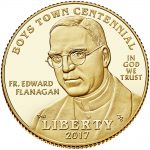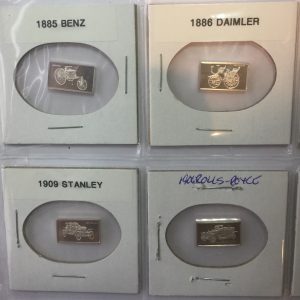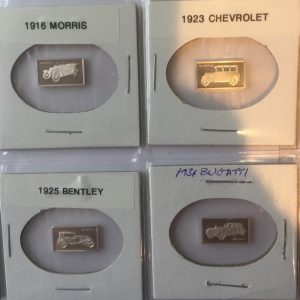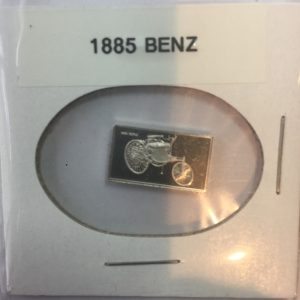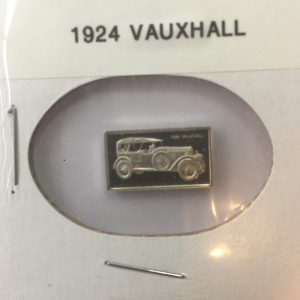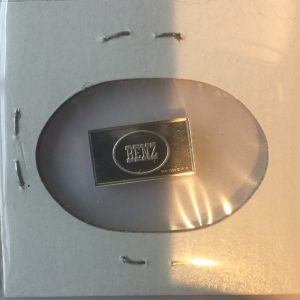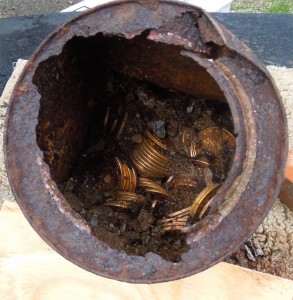Acknowledging the U.S. Mint’s Accomplishments
During the recent media availability, U.S. Mint Director David Ryder said that the U.S. Mint is the only sovereign mint in the world to produce its bullion products since the start of the pandemic without interruption.
When COVID-19 affected the entire population, nobody understood the virus. In a panic, the entire world shut down. We did not understand the effects, but people were getting sick, requiring ventilators and scarce resources, and filling hospitals. For the U.S. Mint, there was an outbreak at the West Point Mint that affected production. They moved production to Philadelphia while those in West Point went into quarantine.
Like many critical businesses, the U.S. Mint reworked its schedule, added health precautions to keep workers safe, and continued production. While the numismatic world was worried about grading bullion coins from Philadelphia as an attempt to make a buck, the U.S. Mint was dealing with the health and safety of their workers.
It puts the industry’s selfishness in perspective.
Analysts give us many reasons why precious metals have risen, and the demand for bullion coins defies the usual analysis. Still, the U.S. Mint has been operating to supply a clamoring market.
Bullion production did slow down. The temporary closing of the West Point Mint reduced the resources they could use to produce bullion coins. There were also production problems by the U.S. Mint’s suppliers in producing the blanks they use. Those businesses were also facing COVID-19 issues that limited their capacity. And do not forget about the mines that could not operate or operated with limited capacity so they can protect their workers.
Ryder said that the procurement staff was diligent in using their resources to ensure the U.S. Mint had the materials to manufacture bullion.
Further limiting the U.S. Mint’s ability to manufacture bullion was the requirement to satisfy the orders for circulating coinage from the Federal Reserve.
As retailers were opening with new precautions, they reported that it was not easy to change because there were not enough coins. Headlines of a “coin shortage” became a topic. When the Federal Reserve investigated the issue, they found there were enough coins in the economy. Because the economy was not moving, circulating coinage was not circulating.
The problem was that the supply chain was interrupted and not moving as expected.
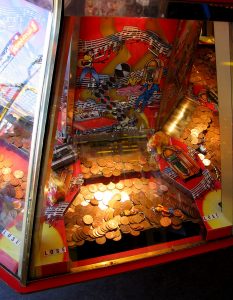
Coin Pusher in a penny arcade. Cambridge Midsummer Fair 2005 (Photograph © Andrew Dunn, cc-by-sa-2.0)
In the pandemic version of the game, the U.S. Mint manufactured coins so the Federal Reserve could dump billions into the economic hopper, hoping that some would fall out into the circulating economy.
In 2020, the U.S. Mint struck 14.774 BILLION coins, 23.7-percent more than they struck in 2019. Nearly every industry reported a reduction in demand and the ability to produce products. And the supply chain continues to affect production in some industries, including tech, where there is a shortage of computer chips. But the U.S. Mint was able to add over 14 BILLION coins to the economy.
The U.S. federal government continues to operate under mandatory pandemic-related protocols. As a federal bureau, the U.S. Mint continues to do its part to maintain social distancing and keeping its workers safe. No company, industry, or government has continued or boosted its production in this manner in the last 18 months.
Remember, the U.S. Mint does this without using any money from the general treasury. Their operating budget comes from the seignorage (profit) from the coin manufacturing process. When the profit exceeds their needs, a portion of the money is deposited in the general treasury. The more money the U.S. Mint makes, the more money they deposit in the general treasury. Talk about a money-making operation.
The U.S. Mint continues to have problems dealing with the collector market. Given the circumstances they have faced over the last 18 months, you have to admire their accomplishments.
Weekly World Numismatic Newsletter for December 24, 2017
News cycles seem to be quiet lately. I wonder what is going on in the world?! 😉
All kidding aside, this past week appears that people are rushing to complete whatever tasks are at hand before the holiday weekend and the end of the year. With everyone celebrating, I am not anticipating anything earth shattering from any news sector.
One thing I will remind those who buy collectibles from the U.S. Mint will stop selling the 2017 Boys Town and Lions Club commemorative coins on December 28. All other coins and medals that will be ending this year, such as anything dated 2016, can be ordered up until December 31.Remember, the U.S. Mint only accepts orders via their website or by calling 800-USA-MINT (800-872-6468).
And now the news…
The Treasury Department will propose the production of coins bearing the face of His Majesty King Maha Vajiralongkorn Bodindradebayavarangkun to the cabinet on Tuesday. Pachara Anantasin, the director-general of the Treasury Department, said Sunday the proposal will be tabled at the day's cabinet meeting.  → Read more at bangkokpost.com
→ Read more at bangkokpost.com
Justice League star Henry Cavill's tradition of giving out "challenge coins" continues and this time it's not just the crew of films he's working on receiving the thoughtful token. Comic book writer and artist Tony Daniel took to Instagram today to share a photo of special token that the Superman actor had sent him.  → Read more at comicbook.com
→ Read more at comicbook.com
The Alaska Mint released its 2018 state coin design this month. Designed by a local university student, Megan Warren found influence for her design from growing up in Alaska and her Native Alaskan Tlingit heritage.  → Read more at anchoragepress.com
→ Read more at anchoragepress.com
Rezwan Razack is building a museum to showcase his collection of Indian paper money dating back to 1812.  → Read more at qz.com
→ Read more at qz.com
The news was celebrated by the Institute of Scrap Recycling Industries and has been a priority for Covanta.  → Read more at wastedive.com
→ Read more at wastedive.com
The “challenge coin” no longer features the presidential seal or national motto. But it does have “Make America Great Again” — twice.  → Read more at washingtonpost.com
→ Read more at washingtonpost.com
Personal Collecting
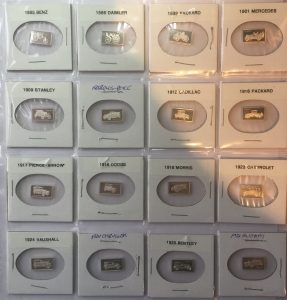 One way to make collecting more fun is to combine interests. One of the members of my local coin club loves cats and has always had one around his house. To help enhance his collecting experience, he collects coins, medals, and tokens with images of cats.
One way to make collecting more fun is to combine interests. One of the members of my local coin club loves cats and has always had one around his house. To help enhance his collecting experience, he collects coins, medals, and tokens with images of cats.
I recently learned that the family of another club member was from Rhodesia. He is working on a collection of Rhodesian coins from before they became Zimbabwe.
Just to complete a thought, a friend’s family came to the United States and 1876 from Eastern Europe. After he traced his family’s history and their path to the United States, he collects coins that were struck in 1876 from the countries his family stopped in during their trip.
My interest is cars. I love the muscle cars of my youth, particular the Mopar muscle. But I love all of the older cars. I think that their designs through the muscle car era had depth and style. Other than the 1959 Cadillac with the biggest fins ever produced in Detroit, I find the Art Deco look of the pre-war cars very appealing.
Recently, I was able to add to my cars and numismatics collection by finding one gram silver ingots with images of vintage cars.
While searching online auctions looking for holiday-related one grams silver ingots to use as gifts, I stumbled across a seller with about two dozen of the ingots with images of classic cars including an 1879 Benz, largely considered the first commercially available automobile. I systematically placed a minimum bid on each of the ingots and decided not to pay any more than one dollar per ingot. When the auctions were over, I won 16 of the 24 that were for sale.
When they arrived, I examined them closely looking for something to indicate who might have made them. Aside from the image of the automobile on the front and the manufacturer on the reverse, there is a sequence number and a copyright that says “476” on the bottom right. The numbers are so small that I needed a 16x loupe to see them.
Each ingot contains 1 gram of .999 silver. At the current price of $16.99 per Troy ounce, each ingot contains 55-cents worth of silver. Since I paid 99-cents for each ingot I think I did pretty well on this deal. They will fit nicely with my Somalia classic cars and motorcycle coins.
If anyone has information as to who created these ingots, please comment below or contact me with the information.
Weekly World Numismatic News for December 17, 2017
When I say found money, I am not talking about that $20 bill you left in your pants pocket or the roll of quarters you left in the center console of your car from a time before electronic toll collection. I am talking about the hoards, metal detector finds, and surprising estate sales that keep popping up in the news.
Over the last few months, there have been a number of stories about someone finding a treasure trove of coins, whether it be gold in California, Roman coins in the United Kingdom, or other ancient coins in Israel, the stories continue to fascinate.
Other than Israel, which is the epicenter of three major religions with a treasure buried beneath her soil, Great Britain appears to be the second most popular area for treasure finds.
According to The Telgraph, the number of discovered treasures rose from 1,005 in 2015 to 1,121 in 2016. It is believed that this number will rise again when 2017 is over.
They attribute the new found interest to a popular BBC sitcom called Detectorists. According to IMDB, it is about the “lives of two eccentric metal detectorists, who spend their days plodding along ploughed tracks and open fields, hoping to disturb the tedium by unearthing the fortune of a lifetime.”
I have not seen this show on U.S. television but it is available on Netflix and Amazon Prime Video.
Given the popularity of this show, I wonder if there may be a way to leverage that idea to do a show centered around numismatics to the public. Maybe it could help expand the hobby.
As an aside, if you are going to try your own search using a metal detector, you might want to read this article from The Mirror. Even though it talks about the hobby in terms for a U.K. readership, the information is transferable to the United States. The article provides good tips.
And now the news….
GovMint.com and ModernCoinMart, in cooperation with S&A Partners – The Official Coca-Cola Licensee for Collectible Coins – has teamed up with Coca-Cola® to bring collectors something they've never seen: legal-tender silver dollars that look like Coca-Cola bottle caps.  → Read more at prnewswire.com
→ Read more at prnewswire.com
MUMBAI, India — Vishal Kumar Jain slid his fingertips along the edges of a crisp 500 rupee ($8) note, a pale grey 150 by 66mm piece of paper. He then ran his hands around a 20-rupee note (0.31 US cents), a 147mm by 63mm orange bill.  → Read more at trtworld.com
→ Read more at trtworld.com
THE Greek word for money, chrema, carries a significance its English translation cannot fully convey. “It means ‘to need’ and ‘to use’ together,” explains Nicholas Stampolidis, director of the Museum of Cycladic Art (MoCA) during a recent visit to the museum’s latest exhibition, “Money: Tangible Symbols in Ancient Greece.”  → Read more at economist.com
→ Read more at economist.com
TEMPO.CO, Jakarta – Bank Indonesia never issue a permit to use candy as a means of transaction replacing rupiah. The use of candies instead of cash for a small exchange mostly found at modern retailers or groceries.  → Read more at en.tempo.co
→ Read more at en.tempo.co
After suffering a serious knee injury that ended her volleyball career at K-State, senior Bryna Vogel was surprised by a presidential token.  → Read more at themercury.com
→ Read more at themercury.com
Friday 15 December 2017  → Read more at churchtimes.co.uk
→ Read more at churchtimes.co.uk
Suspicions are growing that North Korea has resumed forging $100 dollar bills that are so realistic that they are virtually indistinguishable from genuine currency.  → Read more at telegraph.co.uk
→ Read more at telegraph.co.uk
Weekly World Numismatic News for December 10, 2017
I took the job thinking that it could not be that difficult. She said that her late husband was a lifelong collector and had an affinity for half-dollars. It did not sound like a daunting task, so I agreed to meet with her and look at his collection.
Nowadays, when someone calls me for assistance, I usually ask that they take a few pictures with their smartphone and email them so that I can be prepared. In this case that was not possible since my new client did not own a smartphone and expressed displeasure with her “old-fashioned” flip-phone. I was taking a chance.
Rose (not her real name) reminded me of the grandmother-next-door type. Her house was well manicured and the entry reminded me more of the 1950s than any other time. She was neatly dressed as if she was meeting someone of stature. Thankfully, I thought to wear something nicer than my normal jeans and a polo shirt.
We spoke and then she brought me to her late husband’s office. It was quite a contrast from the rest of the house. This was clearly a man’s room whose interest were cars, horses, and coins. Rose said he owned three cars including a 1972 Oldsmobile 4-4-2 (muscle car fans will understand the significance of this car) and had invested in a few racehorses. The cars and the shares in the racehorses were sold but nobody could help her with the coins. Then I found out why.
I was expecting albums, folders, and rolls. When she opened the cabinet, there were five shelves with old cigar boxes, coffee cans, and other containers with loose coins. And while I thought he was a half-dollar collector, he had coins of all types including foreign coins. There were a lot of half-dollars, mostly Walking Liberty halves from the later years and Franklin halves. There was an old metal 35mm film canister with 1964 Kennedy half dollars.
There were several envelopes of foreign currency and Military Payment Certificates he kept from when he was an Army medic in the Korean War.
I have been working with a dealer who specializes in purchasing bulk estates. To help her get the best price, I have been doing a lot of sorting, searching, and ordering of the coins in a manner that would take some of the burdens away from the dealer so he could pay more.
As a bonus, some of the vessels used for storage are also collectibles. The old wooden cigar boxes from Cuba that can be traced to a time before the rise of the Castro regime are highly collectible. So are a few of the coffee cans from brands that have not been heard from in over 50 years including regional brands I had never seen before. That does not include the metal 35mm film canisters. When I asked a dealer, who specializes in old photographic equipment, she made an offer that Rose will probably not refuse.
Considering the size of the accumulation, it will take at least two more days to finish, pack everything, and ship it to the dealer. Although this work is preventing me from writing, I am having a good time. Rose is a nice person and a diehard University of Virginia Cavaliers fan since that was her late husband’s alma mater. Since she decided she likes me, Rose is going to cheer for my Georgia Bulldogs in the upcoming Rose Bowl—which is why I am calling her Rose!
And now the news…
PARIS — Over his 40-year career, the fashion designer Jean Paul Gaultier has had his share of odd requests but until last year, he had never been asked to dress a coin. His imagination has produced outrageous concepts like fitting Madonna into a pointy conical bra, slipping the bearded transgender Eurovision winner Conchita Wurst into a couture dress and sending models down a runway lined with menorahs for his fall 1993 Chic Rabbis collection.  → Read more at nytimes.com
→ Read more at nytimes.com
The staff at Unity's Lincoln Highway Experience have know for some time that future U.S. President William Henry Harrison visited their museum in the mid-1800s, …  → Read more at triblive.com
→ Read more at triblive.com
Washington – At the U.S. Mint in Philadelphia, U.S. Sen. Roy Blunt participated in the ceremonial strike of the 2018 World War I Centennial Silver Dollar honoring the 100th anniversary  → Read more at dailystarjournal.com
→ Read more at dailystarjournal.com
Evidence of Jewish-Muslim influences in early days of Islam may prove interfaith dialogue.  → Read more at jpost.com
→ Read more at jpost.com
This is something, which has been overlooked, the court said.  → Read more at outlookindia.com
→ Read more at outlookindia.com
Sales of U.S. Mint American Eagle gold and silver coins fell sharply year-over-year in November, keeping their tally for the first 11 months of 2017 on track for the weakest year since 2007, the latest data showed on Thursday.  → Read more at reuters.com
→ Read more at reuters.com
Cape Town – The South African Mint, a wholly owned subsidiary of the South African Reserve Bank (SARB), has created a commemorative silver coin in honour of the world’s first successful human-to-human heart transplant 50 years ago.  → Read more at fin24.com
→ Read more at fin24.com
Nearly 150 coin denominations and fables containing 17 years of the 11th-12th centuries have been found in the country’s southern region Lankaran recently.  → Read more at azernews.az
→ Read more at azernews.az
The Widow’s Mites – In Chapter 12 of the Gospel of Mark is a story, a parable, about giving. In summary, the story goes that Jesus and His Disciples were  → Read more at jacksonvilleprogress.com
→ Read more at jacksonvilleprogress.com
Learning from the news of the day
 Although this blog is about numismatics, there are times when the news of the day reminds us that we not perfect beings and there are lessons learned that should apply to the hobby.
Although this blog is about numismatics, there are times when the news of the day reminds us that we not perfect beings and there are lessons learned that should apply to the hobby.
For the last few months, there have been reports about how sexual harassment has been pervasive in industries where men hold a great deal of power. Most people are not surprised when politicians are caught up in these types of activities because we do not hold these people in high regard.
Stories out of the entertainment industry should not be surprising either. It is a system where the “talent,” the faces you see on the television or movie screen, are treated better (or worse) than spoiled children. When I worked for NBC in the early 1990s, I saw first-hand how the talent could do no wrong while their behinds were kissed by the production staff. This created an air of omnipotence that also lead to people being treated badly, something I witnessed regularly.
While there are bad actors in every industry, there seems to be a pattern in male-dominated industries. This is why there is an emphasis on teaching science, technology, engineering, and math (STEM) to girls in order to break the stereotypes. In fact, go to the website of almost any small tech company and look at the list of employees. Not only are most of the employees male, most are white, and what they call diversity includes a male from India or Taiwan. The women listed are in support roles and have no technical responsibility. There are also very few people over 40 years old in most of those companies.
Numismatics is no better. Although the current executive director of the American Numismatic Association is a woman and there quite a few women helping to support the ANA in Colorado Springs, it is not often you see a woman serve on the ANA Board of Governors. The last one was Laura Sperber. While I have disagreed with Sperber, I respect the fact that not only she is a successful business person and had the wherewithal to run for the Board of Governors.
The last time a woman ran for ANA President was in 2009 when Patti Finner, whom I endorsed, lost to Cliff Mishler.
Go to any coin show and count the number of women and minorities behind the tables. A few small shows I have attended were only represented by older white men. At the recent Baltimore Expo although there were a few women, the only one I encountered is one I regularly see who carries foreign currency who is not a native of the United States.
These attitudes are not sustainable for the hobby and society.
Look at the backlash that came when it was announced that the Department of the Treasury wanted to change the portrait on the $20 note to a woman. She would replace Andrew Jackson who ignored treaties and supported the Indian Removal Act that led to the Trail of Tears, an action that is a stain on the nation’s history. There was opposition to these policies during that time. But as Senator William L. Marcy (D-NY) said in defense of Jackson, “To the victor belong the spoils.” One of those spoils is that they get to write the history books and chose figures like Jackson to (dis)honor currency.
But how many people in the numismatic industry stood up for the decision? There were some defenders, but overall there was a deafening silence.
I have complained that the hobby is too white, male, and over the age of 50. I do not think this is sustainable in a changing world, says your blogger who is white, male and over the age of 50. And that can be evident by walking the bourse floor of any coin show.
The old boys club should stop being old and a club of boys. Embracing diversity will only help the hobby because it will bring in new people and new ideas.
Young Numismatist programs help but they should not be the only focus. There is a lack of programs to keep the YN interested and engaged after no longer being YNs. Both male and female YNs become disengaged as they reach young adulthood. I know it is a problem and I keep bringing this up as an issue, it is another time where the silence as to what can be done is defening!
Just because that is the way it has been does not mean it will be the same in the future.
The hobby needs diversity of all types. We need to not only find a way to attract more hobbyists under 50 years old, women, and non-caucasions.
As society grapples with the news about the dozens of men that have been accused of being general pigs and the far too many more that are not associated with the media and are not reported, this hobby has to look at itself and wonder why the bourse floor looks like an old boys club and is that sustainable.
Maybe it is time for the numismatic-related industries to be a leader and show how we can set the stereotypes aside and encourage diversity. Or as the business adage suggests: Diversify or Die!

